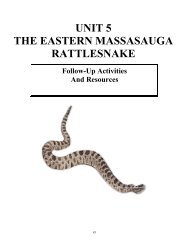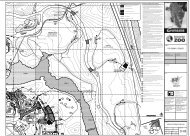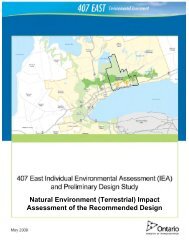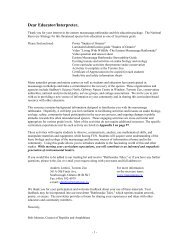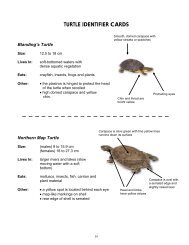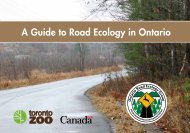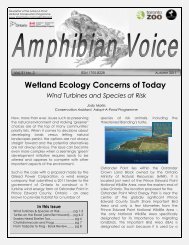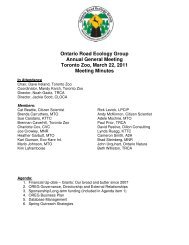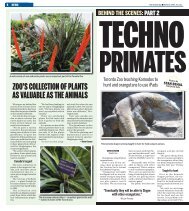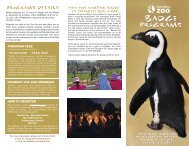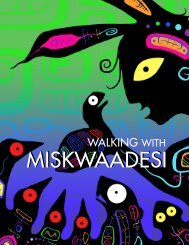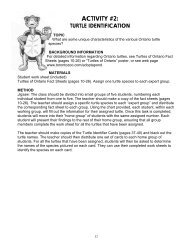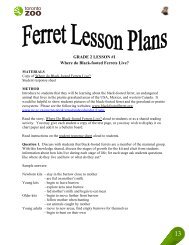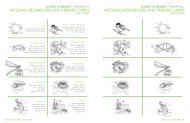Activity Chapter 7 Turtle Families of the World Pg 24 - Toronto Zoo
Activity Chapter 7 Turtle Families of the World Pg 24 - Toronto Zoo
Activity Chapter 7 Turtle Families of the World Pg 24 - Toronto Zoo
You also want an ePaper? Increase the reach of your titles
YUMPU automatically turns print PDFs into web optimized ePapers that Google loves.
ACTIVITY<br />
6.1 TURTLE AND BEAR RACE STORYTELLING<br />
FESTIVAL<br />
Using an arts-based learning strategy, this activity incorporates<br />
Traditional Teachings with literacy and performance.<br />
Materials:<br />
• Walking with Miskwaadesi or<br />
Walking with A’nó:wara book<br />
• Miskwaadesi Races with Makwa<br />
story (located in <strong>Activity</strong> Worksheets<br />
section <strong>of</strong> document) or <strong>Turtle</strong> Races<br />
with Beaver (located in <strong>Chapter</strong> 6 <strong>of</strong><br />
Walking with A’nów:ara)<br />
• Art supplies (paint, markers, modeling<br />
clay, variety <strong>of</strong> pieces <strong>of</strong> fabric, socks<br />
to make sock puppets, etc.)<br />
• Storytelling Festival Planning Guide<br />
(located in <strong>Activity</strong> Worksheets<br />
section <strong>of</strong> document)<br />
Steps:<br />
Ga<strong>the</strong>r a collection <strong>of</strong> teachings,<br />
legends, and stories for students to<br />
potentially read.<br />
Read chapter six <strong>of</strong> Walking with<br />
Miskwaadesi or Walking with A’nó:wara<br />
to <strong>the</strong> class.<br />
After reading Walking with Miskwaadesi,<br />
read Miskwaadesi Races with<br />
Makwa to <strong>the</strong> class. The turtle story for<br />
Haudenosaunee students is found in chapter<br />
six <strong>of</strong> Walking with A’nów:ara.<br />
Ask students if <strong>the</strong>y know any stories and teachings<br />
about animals from <strong>the</strong> wetlands and <strong>the</strong> water. Share<br />
what students already know. The names <strong>of</strong> stories can<br />
be written down so students can ask <strong>the</strong>ir parents,<br />
grandparents, or even Elders about <strong>the</strong>se stories.<br />
Have students work in pairs or small groups to choose a<br />
teaching to present to <strong>the</strong>ir class or to a primary class.<br />
Each student must present a portion <strong>of</strong> <strong>the</strong> story. Students<br />
will be given time to work on this in class.<br />
Also, have students illustrate <strong>the</strong>ir story through <strong>the</strong><br />
use <strong>of</strong> a story board, with puppets, shadow puppets,<br />
pictures, dioramas, plasticine figures, a PowerPoint<br />
presentation, or illustration s<strong>of</strong>tware to help <strong>the</strong>ir<br />
audiences understand <strong>the</strong> story.<br />
Students should create a talking stick to help remember<br />
important parts <strong>of</strong> <strong>the</strong> story. Provide students with a stick<br />
or small piece <strong>of</strong> wood to decorate. Students add<br />
symbols to help remember characters and<br />
elements <strong>of</strong> <strong>the</strong> story. Students can draw,<br />
paint, and decorate <strong>the</strong>se symbols on<br />
<strong>the</strong> stick.<br />
Steps:<br />
Once preparation for <strong>the</strong> festival<br />
is complete, students present<br />
in a storytelling circle. Remind<br />
students to use good voice<br />
techniques and pacing.<br />
Have each group present<br />
<strong>the</strong>ir story or teaching to <strong>the</strong><br />
audience. If possible, record<br />
<strong>the</strong> student presentations and<br />
display, or take pictures <strong>of</strong><br />
<strong>the</strong> talking sticks to display<br />
for o<strong>the</strong>r classes to see.<br />
6.2. TURTLE AND BEAR:<br />
THE GREAT CHASE/TURTLE<br />
AND BEAVER: THE GREAT<br />
CHASE (outdoor activity)<br />
This activity incorporates<br />
physical activity while reinforcing<br />
a teaching from <strong>the</strong> story<br />
Miskwaadesi Races with Makwa<br />
and <strong>Turtle</strong> Races with Beaver.<br />
Materials:<br />
• Play area<br />
Take <strong>the</strong> class outdoors to play a version <strong>of</strong> Tag.<br />
Students become ei<strong>the</strong>r bears and turtles or beavers and<br />
turtles, depending on <strong>the</strong> classes reading <strong>of</strong> Walking with<br />
Miskwaadesi or Walking with A’nów:ara. The bears or<br />
beavers will chase <strong>the</strong> turtles. If a bear/beaver catches a<br />
turtle, <strong>the</strong> turtle is frozen and must wait until ano<strong>the</strong>r turtle<br />
comes to touch it and release it.<br />
CURRICULUM ACTIVITY CHAPTER SEVEN<br />
TURTLES OF THE WORLD<br />
TEACHER BACKGROUND<br />
The activities in this chapter demonstrate <strong>the</strong> worldwide<br />
connection to turtles. The chapter outlines an<br />
understanding that turtles everywhere face dangers, and<br />
issues regarding Ontario turtle species apply to o<strong>the</strong>r<br />
turtles as well. It is suggested that <strong>the</strong> lessons focus on <strong>the</strong><br />
lea<strong>the</strong>rback, a species found <strong>of</strong>f <strong>the</strong> Atlantic and Pacific<br />
Coasts <strong>of</strong> <strong>Turtle</strong> Island.<br />
The activities incorporate experiential learning, map use,<br />
and artistic expression to educate students about <strong>the</strong> risks<br />
and threats to turtles around <strong>the</strong> world. It also identifies <strong>the</strong><br />
importance <strong>of</strong> turtles to Aboriginal people worldwide.<br />
THE EIGHT SPECIES OF<br />
SEA TURTLES:<br />
The Lea<strong>the</strong>rback (Dermochelys coriacea)<br />
• Found in oceans <strong>of</strong>f <strong>the</strong> coasts <strong>of</strong> atlantic and pacific<br />
canada<br />
• The largest sea turtle; grows up to 7 feet long and<br />
weighs at least 1200 pounds<br />
• Has thin, tough, rubbery skin instead <strong>of</strong> a hard shell;<br />
5 distinct ridges are formed by small bones buried in<br />
<strong>the</strong> skin<br />
• Feed <strong>of</strong>f Nova Scotia, but each fall travel to <strong>the</strong><br />
caribbean to nest<br />
• Carapace is black with white spots; <strong>the</strong> plastron is<br />
whitish to black<br />
• Can dive <strong>the</strong> deepest and travel <strong>the</strong> fur<strong>the</strong>st <strong>of</strong> any<br />
o<strong>the</strong>r sea turtle<br />
• Have powerful front flippers to aid in strong swimming<br />
• Rarely seen, except on nesting beaches<br />
• Jellyfish are <strong>the</strong> main component <strong>of</strong> <strong>the</strong>ir diet<br />
• Exploited for eggs<br />
23 CURRICULUM-BASED ACTIVITIES GUIDE TURTLE ISLAND CONSERVATION <strong>24</strong>
The Loggerhead (Caretta caretta)<br />
• Has an anti-tropical<br />
distribution<br />
• Found in Nor<strong>the</strong>rn and<br />
Sou<strong>the</strong>rn Indian Ocean,<br />
Australia, Japan, and <strong>the</strong><br />
Sou<strong>the</strong>astern US; also found<br />
in <strong>the</strong> Atlantic Ocean <strong>of</strong>f eastern Canada<br />
• The loggerhead can grow between 32-41 inches<br />
and can weigh up to 350 pounds<br />
• Identified by its large head and reddish brown<br />
carapace (upper shell) and dull brown or yellow<br />
plastron<br />
• Has powerful jaws for eating shellfish living on <strong>the</strong><br />
bottom <strong>of</strong> <strong>the</strong> ocean<br />
• Suffers from accidental capture<br />
The Green <strong>Turtle</strong> (Chelonia mydas)<br />
• Circum-global species; nesting and feeding grounds<br />
are in <strong>the</strong> tropics<br />
• Most common <strong>of</strong> <strong>the</strong><br />
eight sea turtles<br />
• One <strong>of</strong> <strong>the</strong> largest<br />
species <strong>of</strong> sea turtles;<br />
shells can be up to 3<br />
feet long and weigh<br />
up to 300 pounds<br />
• Named for <strong>the</strong> green color <strong>of</strong> <strong>the</strong> fat under <strong>the</strong> shell,<br />
not for <strong>the</strong> actual color <strong>of</strong> <strong>the</strong> shell, which can range<br />
from a greenish shade, to brown, black, or even gray<br />
• Feed on sea grasses and seaweed<br />
• Harvested for meat and eggs in Costa Rica,<br />
Caribbean, Indonesia, and Panama; cartilage is<br />
used in Asian countries for turtle soup<br />
The Black <strong>Turtle</strong> (Chelonia<br />
agassazii)<br />
• Confined to <strong>the</strong> Eastern<br />
Pacific Ocean<br />
• Protected in <strong>the</strong> Galapagos<br />
and nominally in Mexico;<br />
subject to illegal harvest elsewhere named for <strong>the</strong><br />
black or gray color <strong>of</strong> its shell<br />
The Flatback <strong>Turtle</strong> (Natator depressus)<br />
• Confined to <strong>the</strong> Eastern<br />
Pacific Ocean<br />
• Protected in <strong>the</strong><br />
Galapagos and<br />
nominally in Mexico;<br />
subject to illegal harvest<br />
elsewhere<br />
• Named for <strong>the</strong> black or gray color <strong>of</strong> its shell<br />
The Hawksbill<br />
(Eretmochellys imbricata)<br />
• Common in<br />
tropical reefs <strong>of</strong> <strong>the</strong><br />
Caribbean islands<br />
and Australia<br />
• One <strong>of</strong> <strong>the</strong> smaller<br />
sea turtle species; grows 30-36 inches and<br />
weighs100-150 pounds<br />
• Narrow head and beak make it look like a hawk;<br />
shell is reddish brown with yellow streaks<br />
• Feeds on encrusting animals such as sponges, sea<br />
barnacles, and seaweed<br />
• These turtles are subject to intense intentional trade;<br />
beautifully patterned shell is a source <strong>of</strong> tortoise shell<br />
used to make jewelry and combs<br />
The Olive Ridley<br />
(Lepidochelys olivacea)<br />
• Nests mainly in <strong>the</strong><br />
Pacific Ocean, around<br />
Costa Rica, Mexico and<br />
Nicaragua, as well as <strong>the</strong> Nor<strong>the</strong>rn India Ocean<br />
• One <strong>of</strong> <strong>the</strong> smallest, weighing less than 100 pounds<br />
• Olive green in color, giving it its name<br />
• Most abundant species <strong>of</strong> sea turtle<br />
The Kemp’s Ridley<br />
(Lepidochelys kemp)<br />
• Only nests on one beach<br />
in <strong>the</strong> world, in Rancho<br />
Nuevo, Mexico<br />
• The smallest sea turtle;<br />
grows to be <strong>24</strong>-28 inches and weighs 77-100 pounds<br />
• Carapace is olive green, and its plastron is yellowish<br />
• The rarest species <strong>of</strong> sea turtle as well as <strong>the</strong> most<br />
endangered<br />
TURTLES AROUND THE<br />
WORLD:<br />
1. North America: North America: In many First Nation<br />
Creation Stories, <strong>the</strong> turtle has <strong>the</strong> responsibility <strong>of</strong><br />
carrying <strong>the</strong> Earth on its back. The great turtle which<br />
holds up <strong>the</strong> earth is a symbol <strong>of</strong> wisdom and kindness.<br />
<strong>Turtle</strong> rattles are used in ceremonies.<br />
2. India: The tortoise is supported by <strong>the</strong> elephant and<br />
<strong>the</strong> elephant holds up <strong>the</strong> world.<br />
3. China: The turtle represents strength, endurance,<br />
slowness, long life, fertility, and it is shown on <strong>the</strong><br />
imperial banner as an emblem <strong>of</strong> protection in war.<br />
4. Japan: The sea turtle represents Kumpira, <strong>the</strong> protector<br />
<strong>of</strong> sailors.<br />
5. Africa: Tortoise is an emblem <strong>of</strong> protection and is a<br />
masculine symbol <strong>of</strong> fertility.<br />
6. Greece: In ancient times, turtles were emblems <strong>of</strong><br />
Aphrodite because <strong>the</strong> turtle was associated with females<br />
and water.<br />
7. Mayans (ancient Mexico): The turtle was associated<br />
with water, land, and thunder.<br />
8. Tonga: Sea turtles are a special symbol <strong>of</strong> longevity,<br />
good fortune, and fertility.<br />
9. Samoa: Sea turtle is a graceful swimmer and also<br />
represents freedom.<br />
10. New Zealand: The sea turtle is unique because<br />
it has flippers instead <strong>of</strong> feet but it must still leave its<br />
‘home’ in <strong>the</strong> ocean to crawl ashore, dragging its great<br />
shell without complaining or hurrying to lay its eggs.<br />
Perseverance, patience, and virtue are also identified<br />
with sea turtles.<br />
Mating: During <strong>the</strong> mating season, all species <strong>of</strong> marine<br />
turtles migrate from feeding areas to mating areas. After<br />
mating, <strong>the</strong> males return to foraging areas while females<br />
proceed to nesting beaches. Some turtles migrate more<br />
than 2600 kilometres, but most travel less than 1000<br />
kilometres. Female turtles generally do not reproduce<br />
every year but males may breed every year. Mating can<br />
occur anywhere in <strong>the</strong> water, but it usually takes place at<br />
<strong>the</strong> surface.<br />
Nesting: Most females lay over 100 eggs in several<br />
clutches, reducing <strong>the</strong> risk <strong>of</strong> potential hatchling loss.<br />
This can be done at 2 week intervals. Eggs hatch after<br />
25 CURRICULUM-BASED ACTIVITIES GUIDE TURTLE ISLAND CONSERVATION 26
6 to 13 weeks <strong>of</strong> incubation,<br />
depending on <strong>the</strong> temperature.<br />
They generally hatch in <strong>the</strong> early<br />
evening. Hatchlings can tell whe<strong>the</strong>r<br />
it is evening or daytime based on<br />
<strong>the</strong> temperature <strong>of</strong> <strong>the</strong> sand. If eggs<br />
hatch during <strong>the</strong> day, <strong>the</strong>y would<br />
have to face excessive heat and<br />
predation. Hatchlings wait until<br />
evening to break <strong>the</strong> sand’s surface.<br />
If <strong>the</strong>y start digging and <strong>the</strong> sand<br />
gets progressively warmer, <strong>the</strong>y will<br />
wait until <strong>the</strong> sand cools.<br />
Navigation: After hatching, sea<br />
turtles primarily use vision to find <strong>the</strong><br />
sea, moving toward <strong>the</strong> brightest<br />
light, presumably <strong>the</strong> moon. They<br />
move away from elevated silhouettes,<br />
such as sand dunes and vegetation.<br />
<strong>Turtle</strong>s also rely on wave cues to<br />
swim <strong>of</strong>fshore, moving toward<br />
approaching waves. They sense<br />
<strong>the</strong> wave motion under water<br />
by monitoring <strong>the</strong> sequence <strong>of</strong><br />
accelerations <strong>the</strong>y experience in <strong>the</strong><br />
water column. <strong>Turtle</strong>s emerge from<br />
<strong>the</strong>ir nests without an established<br />
directional preference. The hatchlings<br />
also follow <strong>the</strong> intensity <strong>of</strong> <strong>the</strong> earth’s<br />
magnetic field, not <strong>the</strong> poles.<br />
Conservation: Sea turtles worldwide<br />
are being protected under <strong>the</strong><br />
endangered species list in addition<br />
to federal agencies. Efforts are<br />
being made to educate local people<br />
about <strong>the</strong> importance <strong>of</strong> <strong>the</strong>se<br />
marine reptiles, not only for future<br />
generations, but also for <strong>the</strong> health<br />
<strong>of</strong> <strong>the</strong> environment.<br />
Unfortunately, sea turtles continue<br />
to be killed in drift nets; in feeding<br />
areas; when nearing <strong>the</strong> shore to<br />
nest; taken as eggs for alcoholic<br />
beverages; and are killed as<br />
adults for souvenirs, food, and<br />
shell products. <strong>World</strong>wide, help is<br />
needed to save <strong>the</strong>se remarkable,<br />
ancient, endangered animals.<br />
Currently, <strong>the</strong>re are attempts being<br />
made to help protect <strong>the</strong>se species<br />
and increase <strong>the</strong>ir populations.<br />
Fishermen help <strong>the</strong> Lea<strong>the</strong>rback<br />
Working Group in Nova Scotia to<br />
release lea<strong>the</strong>rbacks caught in nets.<br />
Shrimp trawling is ano<strong>the</strong>r large<br />
problem for sea turtles as many<br />
are caught in <strong>the</strong> nets and drown.<br />
TEDs (<strong>Turtle</strong> Exclusion Devises) were<br />
developed to reduce <strong>the</strong> number <strong>of</strong><br />
sea turtles caught in trawling nets.<br />
TED’s are trap doors in nets which<br />
allow <strong>the</strong> sea turtles, but not <strong>the</strong><br />
shrimp, to escape. Shrimp farms<br />
are also being established to limit<br />
<strong>the</strong> accidental capture <strong>of</strong> turtles<br />
and o<strong>the</strong>r marine animals. <strong>Turtle</strong><br />
hatcheries help reduce <strong>the</strong> decline <strong>of</strong><br />
sea turtle populations by removing<br />
<strong>the</strong> eggs from nests where <strong>the</strong>y may<br />
be eaten by predators or removed<br />
by poachers. The eggs are taken to<br />
a hatchery where <strong>the</strong>y are incubated<br />
and later released. In Atlantic<br />
Canada, scientists work with <strong>the</strong><br />
fishermen to conserve lea<strong>the</strong>rback<br />
and loggerhead sea turtles.<br />
The Native American people <strong>of</strong><br />
Hawaii have a special relationship<br />
with <strong>the</strong> sea turtles which make <strong>the</strong>ir<br />
home on <strong>the</strong> Hawaiian Islands.<br />
Students will find a story about a<br />
memorial that was installed to honour<br />
Kauila, a sea turtle in 1995 by going<br />
to <strong>the</strong> turtle website at:<br />
http://www.turtles.org/monu.htm<br />
Additional Resources:<br />
Nova Scotia Lea<strong>the</strong>rbacks<br />
www.seaturtle.ca<br />
Hinterland Who’s Who: Amphibian &<br />
Reptile Fact Sheet<br />
Lea<strong>the</strong>rback Seaturtle<br />
http://www.hww.ca/hww2.asp?id=33<br />
Sea <strong>Turtle</strong> Conservancy: Information About<br />
Sea <strong>Turtle</strong>s, Their Habitats and Threats to<br />
Their Survival<br />
http://conserveturtles.org/<br />
seaturtleinformation.php<br />
Sea <strong>Turtle</strong> Conservation Bonaire<br />
http://www.bonaireturtles.org<br />
Sea <strong>World</strong>: Sea turtles<br />
http://www.seaworld.org/animal-info/<br />
info-books/sea-turtle/index.htm<br />
Challenge Seven- <strong>Turtle</strong>s <strong>of</strong> <strong>the</strong> <strong>World</strong><br />
ACTIVITY<br />
7.1 TURTLES OF THE WORLD<br />
With <strong>the</strong> use <strong>of</strong> various learning<br />
strategies including guided<br />
exploration and map making, this<br />
activity incorporates map use and<br />
literacy, while demonstrating <strong>the</strong><br />
importance <strong>of</strong> turtles to cultures all<br />
over <strong>the</strong> world.<br />
Materials:<br />
• <strong>Turtle</strong>s <strong>of</strong> <strong>the</strong> <strong>World</strong> information<br />
sheets (found in Teacher<br />
Background)<br />
• Map <strong>of</strong> <strong>the</strong> world<br />
• Atlases<br />
Steps:<br />
Read <strong>the</strong> information from ‘<strong>Turtle</strong>s<br />
<strong>of</strong> <strong>the</strong> <strong>World</strong>,’ found in <strong>the</strong> Teacher<br />
Background, to introduce students<br />
to <strong>Turtle</strong> Teachings from around <strong>the</strong><br />
world. Make a chart identifying <strong>the</strong><br />
characteristics that people identify with<br />
turtles globally.<br />
Demonstrate or review how to use<br />
an atlas. This includes how to use<br />
<strong>the</strong> index.<br />
Ask students to work in<br />
pairs or small groups<br />
with an atlas and<br />
<strong>the</strong> teacher<br />
provided map. Students will find <strong>the</strong><br />
thirteen countries that have a special<br />
relationship with turtles and label <strong>the</strong>m<br />
on <strong>the</strong> world map.<br />
Create a legend on <strong>the</strong> map to identify<br />
<strong>the</strong> various places and nations. Distinct<br />
symbols and colours can be used to<br />
express locations or <strong>the</strong>mes. This makes<br />
<strong>the</strong> map easier to read, and will assist<br />
in understanding <strong>the</strong> map.<br />
7.2 NETTING HEADACHES<br />
This activity incorporates<br />
experiential learning related to<br />
biodiversity and sustainability<br />
through <strong>the</strong> use <strong>of</strong> an activity-based<br />
learning strategy, simulation.<br />
Materials:<br />
• Small paper cups (2 per each<br />
group)<br />
• Large spoons<br />
• Large bag <strong>of</strong> coloured candies<br />
(Smarties, Skittles, etc.)<br />
• Two or three boxes <strong>of</strong> pop rocks<br />
• Netting Headaches Chart<br />
(located in <strong>Activity</strong> Worksheets<br />
section <strong>of</strong> document)<br />
Steps:<br />
Premix <strong>the</strong> two types <strong>of</strong> candies<br />
(Pop Rocks and larger candies) in a<br />
large bowl.<br />
Divide <strong>the</strong> class into small groups. Give<br />
each group a spoon (trawling net), an<br />
empty cup (boat), and a tally chart.<br />
As a class, review <strong>the</strong> colours for <strong>the</strong><br />
captured sea creatures. The coloured<br />
candies represent different ocean<br />
species that are accidentally caught in<br />
traps. The Pop Rocks represent shrimp<br />
(Note: <strong>the</strong>se candies are smaller and<br />
more difficult to catch and represent<br />
what happens as <strong>the</strong> trawl nets try to<br />
trap <strong>the</strong> small shrimp).<br />
Provide each group with half a cup<br />
<strong>of</strong> <strong>the</strong> mixed candy. Group members<br />
each take a spoonful <strong>of</strong> candies<br />
from <strong>the</strong>ir cup and place <strong>the</strong> candies<br />
into <strong>the</strong> empty boat, recording <strong>the</strong><br />
number <strong>of</strong> each colour <strong>of</strong> candy <strong>the</strong>y<br />
catch in <strong>the</strong> chart.<br />
Each group member ‘goes fishing’<br />
and compiles <strong>the</strong> results. Subtract<br />
<strong>the</strong> total number <strong>of</strong> shrimp caught<br />
from <strong>the</strong> overall total in order to see<br />
<strong>the</strong> amount <strong>of</strong> by catch that results in<br />
shrimp harvesting.<br />
Discuss <strong>the</strong> findings and <strong>the</strong> overall<br />
costs <strong>of</strong> trawling and net fishing to<br />
<strong>the</strong> marine environment. Discuss<br />
why this is decreasing sea turtle<br />
populations, and what can be done<br />
to prevent this (type <strong>of</strong> nets, etc.).<br />
Extension: This activity could also be<br />
used to demonstrate how to create a<br />
pie chart.<br />
7.3 SEA TURTLE AWARENESS<br />
POSTER<br />
This activity incorporates artistic<br />
expression with knowledge related to<br />
biodiversity and conservation.<br />
Materials:<br />
• Paper and writing tools<br />
• Art supplies (markers, crayons, etc.)<br />
Steps:<br />
Have students individually create<br />
an awareness poster for Canada's<br />
lea<strong>the</strong>rback sea turtles. The poster<br />
should include an explanation <strong>of</strong> why<br />
<strong>the</strong>re are problems for sea turtles,<br />
what would happen if sea turtles no<br />
longer existed, and how each student<br />
can make a difference. The poster<br />
should also include artistic elements.<br />
27 CURRICULUM-BASED ACTIVITIES GUIDE TURTLE ISLAND CONSERVATION 28



